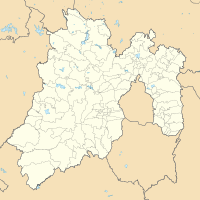Xico (México)
| Xico | ||
|---|---|---|
|
Coordinates: 19 ° 18 ′ N , 98 ° 56 ′ W Xico on the map of Mexico
|
||
| Basic data | ||
| Country | Mexico | |
| State | México | |
| Municipio | Valle de Chalco | |
| Residents | 417,900 (2019) | |
| Detailed data | ||
| surface | 27.3 km² | |
| height | 2235 m | |
Xico is a city in the Mexican state of México . It serves as the capital of the Municipio Valle de Chalco , with which it is practically identical. The city is located on the east side of the Federal District and is part of the Mexico City metropolitan area . The city and the community lie on the old lakeshore of Lake Chalco, which like much of the Mexican basin was drained. The name of the city comes from the nearby hill Xico (Cerro de Xico).
history
Early history refers to the area around the Cerro de Xico and the island of Xico, as most of the modern city was under water until a relatively short time ago. The area consisted mainly of fishing villages from 900 BC. BC to 100 AD. From 550 to 650 the area was shaped by the Teotihuacán culture . From 650 to 750 an Otomí settlement gained importance. The Acxotecas arrived around 1328, when chinampa farming began here. Xico was conquered by the Aztec Tezozómoc in 1381 , after which groups of Mexica settled here, who expanded the cultivation system in the 14th and 15th centuries. The area was ceded to Hernán Cortés by the Spanish king in 1529 . The modern area emerged in the 19th century when President Porfirio Díaz ordered the drainage of Lake Chalco, which destroyed the economy of the former coastal communities. The Mexican Revolution attempted to compensate for these communities by creating ejidos . The two largest here were Estación Xico with 507 hectares and San Miguel Xico with 250 hectares.
For the most part, the area was nearly idle until the late 1970s, when families from central and southern Mexico moved to the area in search of land. Despite its proximity to Mexico City, there was hardly any infrastructure for basic services, including schooling for children. Many people bought ejido land, which created legal problems. The federal government had to step in to ensure basic services and regulate the property rights of more than 77,000 parcels of ejido land sold. The area finally became its own municipality in 1994. At the 2005 census, Xico had 331,321 residents.
Individual evidence
- ↑ Valle de Chauco. Retrieved February 5, 2020 .
